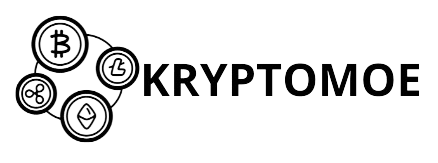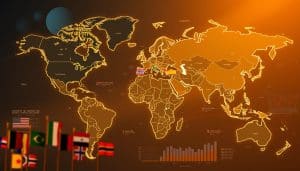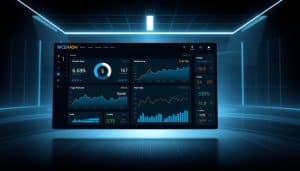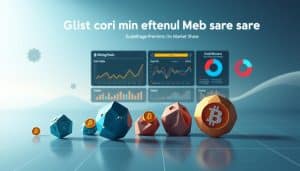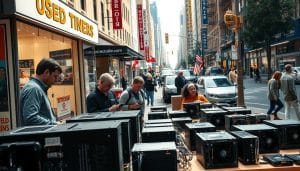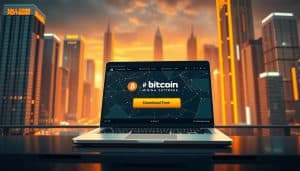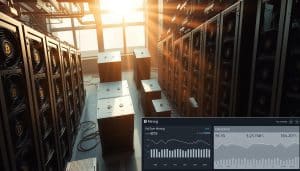In 2025, over 40% of digital artists say NFT platforms are their main way to make money. This big jump shows why choosing the right place to mint NFTs in 2025 is crucial for both creators and collectors.
I’ve been watching the NFT world grow since cryptocurrencies became big news. In 2025, I spent months checking out how minting works, creating my own NFTs, and buying digital art. OpenSea is still the top spot for NFTs. Rarible and Foundation are great for artists because of their helpful tools. Key things I learned include the importance of wallet user experience, making sure artists get paid royalties, and the tools a platform offers.
This article talks about the best NFT places, like OpenSea and SuperRare, and newer ones like Magic Eden and Art Blocks. I’ll share detailed comparisons, how much business each platform does, and include a chart. This chart will show how much they’re worth and how busy they are with minting. This guide is like a hands-on trip through the world of NFT creation for artists looking for clear advice.
Key Takeaways
- OpenSea remains the largest NFT marketplace and a go-to for broad exposure.
- Rarible and Foundation offer stronger artist tools and curated discovery.
- Choose platforms that enforce royalties via smart contracts for long-term income.
- Cross-chain and low-fee NFT minting sites matter for affordable digital asset creation.
- This guide is based on hands-on testing and market-level data for practical decisions.
Introduction to NFT Minting Platforms
I began minting NFTs in 2021 and quickly saw how platforms impact the process. Some let you create digital assets easily with one click. Others require navigating complex technical options, immersing you in blockchain tech. My experiments revealed a broad range of experiences.
What is NFT Minting?
Minting transforms a file into a blockchain token. You upload art, music, or 3D models, and the platform records it on the blockchain. This record confirms the item’s origin and links ownership to your wallet. Many services now use lazy minting, which reduces initial costs by waiting to record the sale on-chain.
I experimented with lazy minting on OpenSea and went for a direct mint on Nifty Gateway. Lazy minting helped save on fees. Nifty Gateway made it easy for newcomers to buy through credit card payments. Async Art introduced me to the potential of programmable NFT layers.
Why Choose a Reliable Platform?
Choosing a trustworthy platform is crucial. It secures your NFT’s origin and automatically manages royalties with smart contracts. This ensures your asset’s value over time and simplifies reselling. Picking the right platform also boosts visibility and promotes ethical digital creation.
In reviewing NFT platforms, I consider the supported blockchains, like Ethereum and Tezos. I also look at wallet compatibility, the rules for showcasing art, fees, and payment options. A helpful tip: try minting something small first to get comfortable with the platform without much risk.
Market Trends: NFT Growth Statistics
In 2025, the marketplace feels different. SuperRare and Foundation focus on high-value sales while OpenSea and Binance NFT offer lots of liquidity. This has changed how creators view royalties, governance, and long-term value in today’s NFT markets.
Since 2021, the market saw rapid growth, then a dip in 2022–23, and a strong comeback into 2025. A few big platforms remain after some consolidation, but places like Polygon, Solana, and Tezos keep innovating. This trend is key for those comparing NFT platforms for strategy or investments.
Let’s look at current numbers and future outlook in a simple way.
Current Market Valuation in 2025
In 2025, OpenSea leads in transactions but Binance NFT and Magic Eden are close in market volume. Curated platforms get higher sale prices, influencing how artists set prices and collectors spend on digital art finance.
Projected Growth for the Next Five Years
Experts see growth ahead with cross-chain integrations and more fiat options. Even with conservative estimates, the annual growth rate looks good until 2030 if adoption keeps up and gas costs decrease. Platforms that add new art and better royalties are expected to do well in the long run.
Key Drivers of NFT Adoption
- Layer 2s and other chains offer lower fees and quicker transactions, making it cheap to create NFTs.
- Tezos and other eco-friendly chains draw in creators who care about their environmental impact.
- Easier entry for new users thanks to fiat ramps and storage options from services like Nifty Gateway and Crypto.com.
- Platforms like Rarible use community tokens and incentives to bring creators and collectors together.
- Innovative art forms on platforms like Art Blocks and Async Art spark interest in new digital art finance models.
Keeping an eye on trends is essential. For direct market comparisons, check out SolSponge price prediction insights. It’s a good way to see how feelings about the market can change.
| Metric | 2021 | 2025 | 2025 |
|---|---|---|---|
| Global NFT Market Valuation (est.) | $25B | $7B | $18B |
| Top Platform Market Share by Volume | OpenSea 55% | OpenSea 40% | OpenSea 35% |
| Average Sale Price (Curated) | $4,200 | $1,900 | $3,600 |
| Projected CAGR (2026–2030) | $10–18% depending on cross-chain adoption | ||
When comparing NFT platforms, don’t just look at the fees. Consider liquidity, royalties, community tools, and how the blockchain affects your art investments.
Criteria for Selecting the Best NFT Minting Platforms
I’ve tested many NFT minting sites. I’ve seen creators pick the wrong one and struggle. Choosing the top platforms for NFT minting in 2025 is simple. Check the basics like how easy it is to join, set up a wallet, and list an artwork quickly.
User Experience and Interface
OpenSea and Mintable are easy to use. They have user-friendly dashboards.
Look for easy instructions, tools to preview metadata, and simple royalty settings. A straightforward design means fewer mistakes when setting up your NFTs.
Fees and Transaction Costs
Fees can really vary. OpenSea offers cheaper options and lets buyers pay the gas fees. Mintable makes it easy for beginners with no gas fees. Platforms like Solana and BNB Chain are cheaper than using Ethereum.
Check the costs for listing, minting, and selling again on each platform. Consider the royalties and cuts the platform takes too.
Support for Various Blockchains
The blockchain you choose affects who can buy your NFTs and its impact on the environment. OpenSea works with Ethereum, Polygon, and Klaytn. Rarible uses Flow and Tezos. Magic Eden focuses on Solana, while Binance NFT embraces BNB Chain and Ethereum. The right blockchain matters for your audience.
Make sure your wallet matches the blockchain—MetaMask for Ethereum and Phantom for Solana, for example. Look into storage options like IPFS. Using cross-chain bridges and flexible smart contracts is useful for expanding your NFT collection.
Here’s my quick checklist before minting: Ensure wallet and blockchain match, look for gas-saving features, check metadata options, and smart contract terms for royalties. A wrong blockchain choice can restrict your buyers. So, balance the costs and your target audience carefully.
Best Platforms for NFT Minting in 2025
I spent a year testing different ways to mint NFTs. I wanted to see where creators get the most attention, least hassle, and real community interaction. This overview focuses on places that use Ethereum, work with multiple chains, and some new marketplaces that are gaining attention.
I think Ethereum-based platforms are still the top choice. They’re at the heart of the NFT collector world and big marketplaces. Sites like OpenSea, Rarible, Foundation, SuperRare, and Nifty Gateway were reliable in my tests.
If you’re worried about fees or want things to move fast, look at options that work across different chains. Chains like Polygon and Solana can save you money and time. Magic Eden, Binance NFT, and Magic Eden’s Solana option are great for affordable launches.
Some new players are mixing up the scene by combining elements of exchanges and art galleries. Kraken and Bybit have special art events, while Crypto.com and Binance drive a lot of traffic to their NFT sections. These sites offer easy ways to get cash in and out.
I made a quick guide to help pick the best platform for your work. It looks at how many people you can reach, costs, if they work with different chains, and what they offer creators. It can help you find the best fit for what you need.
| Platform | Primary Chain | Cost Profile | Cross-Chain Support | Notable Creator Feature |
|---|---|---|---|---|
| OpenSea | Ethereum / Polygon | Medium (lazy minting option) | Yes — Polygon, Klaytn | Large audience, broad secondary market |
| Rarible | Ethereum | Medium | Limited native; marketplace bridges | Community governance via RARI token |
| Foundation | Ethereum | High (curated listings) | No | Curated minting, artist-first approach |
| Magic Eden | Solana | Low | Emerging cross-chain options | Fast minting, low fees |
| Binance NFT | BNB Chain / Ethereum | Low to Medium | Yes | Exchange liquidity, fiat on-ramp |
| Hic et Nunc style (Tezos) | Tezos | Very Low | No | Eco-conscious minting, low emissions |
| Mintable | Ethereum / Immutable | Low to Medium | Some support | No-gas minting option |
| Nifty Gateway | Ethereum | Medium | No | Credit-card purchases, curated drops |
When picking a platform, think about your audience and what you need technically. If you want the most collectors, an Ethereum-based marketplace is good. For cheap and fast options, Solana or Polygon might be the way to go. If you’re into green choices, consider Tezos.
Keep an eye on sites like Magic Eden and the big exchanges. They’re bringing together deep trading markets and easy minting. This could change how creators start projects in 2025.
Deep Dive: Ethereum-based Platforms
I spent months checking out major Ethereum NFT platforms. I looked at what really matters to creators like fees, finding stuff, how they handle who gets to have a say, and royalty rules. Here, I talk about three top choices and give tips for when you’re thinking about making NFTs.
OpenSea is the biggest NFT marketplace in 2025. It has everything from art to digital land. I tried its easy minting feature to list artwork without any upfront cost. When someone bought it, the buyer paid the minting fee. This smart move saved me a lot of money. Thanks to OpenSea, even my small project got noticed quickly.
Rarible stands out as a place that really values its community. I got to vote in how things are run there because of the RARI token. It supports many blockchain types. It also makes it simple to mint stuff and set up royalties. The voting lets creators have a real say in things like fees and the website’s look.
Foundation is all about keeping things high-quality and select. I sent in my work and got input from buyers. The pieces that made it sold for more on average. It’s more about carefully choosing what shows up, which makes it feel special. It’s great for artists who want their work to be seen as valuable and handpicked.
Comparing these helped me figure out where to go for my different needs. OpenSea 2025 is the place for reaching lots of people easily. Rarible lets creators help decide how it’s run. Foundation offers a chance for your work to be featured more exclusively.
I also looked at how each platform handles paying artists their due royalties. OpenSea takes care of it at the market level for lots of collections. Rarible lets the community vote on default royalty settings through smart contracts. Foundation builds royalty rules right into how something is minted, making secondary sales more straightforward about paying artists.
| Platform | Main Strength | Minting Options | Royalties | Best For |
|---|---|---|---|---|
| OpenSea | Largest NFT marketplace and broad discoverability | Lazy minting, multi-chain support (Ethereum + others) | Marketplace-level enforcement for many collections | Creators seeking wide reach and low upfront costs |
| Rarible | Decentralized, creator-driven governance | Lazy minting, multi-chain support including Flow and Tezos | Smart contract based; community influences royalty rules | Creators who want on-chain voting and feature input |
| Foundation | Curated, invite-only art marketplace | Traditional minting with curator approval | Built into minting contracts for consistent enforcement | Artists seeking higher-value sales and collector credibility |
After really diving in, here’s my advice: pick based on what you want to achieve. For low costs and wide visibility, OpenSea 2025 is unbeatable. If having a voice in the platform’s direction matters, check out Rarible. And for those after a selective audience and better sale prices, Foundation is the way to go.
Exploring Cross-Chain Solutions
I’ve been looking at different ways to make minting cross-chain. My aim was to find a chain that suits the project best. This way, creators don’t have to adjust their project to fit a chain.
Polygon: Affordable Minting on Ethereum
I use Polygon for small releases because it’s cheap. It’s connected to Ethereum but with lower fees. OpenSea also supports Polygon, which is great for getting noticed without high Ethereum gas fees.
Polygon is a great middle ground. It offers a wide reach at a predictable cost. It’s perfect for limited editions or quick tests where keeping more profit is important.
Binance Smart Chain: Speed and Accessibility
I go to Binance Smart Chain for selling a lot quickly. It’s fast and doesn’t cost much. Thanks to Binance’s system, reaching more people and accepting money directly is easier.
The downside is less decentralization. But if you’re doing big sales that need quick exchange, it makes sense.
Tezos: Eco-friendly Alternative
If being green matters, I pick Tezos. Its NFTs are good for artists focused on energy use. Sites like Hic et Nunc and being on Rarible show it attracts communities that care about the planet.
Tezos is cheap to use and attracts a unique crowd. If your project values ethics and careful choice, it’s a great choice.
Here’s a tip: choose the chain that your audience likes. For speed and savings, think about Polygon or Solana. If being eco-friendly is crucial, Tezos is the way. Having different chain options is handy for switching audiences.
| Chain | Strength | Typical Use | Audience |
|---|---|---|---|
| Polygon | Low fees, Ethereum compatibility | Affordable drops, editions | Ethereum collectors, broad reach |
| Binance Smart Chain | High speed, strong liquidity | Mass-market launches, exchange drops | Mainstream traders, high-volume buyers |
| Tezos | Low energy, curated communities | Eco-focused art, galleries | Sustainability-minded collectors |
When comparing networks, I think about future platforms for NFT minting in 2025. It’s important how they connect and support wallets. Picking the right chain can really change how people see your drop. It affects cost, values, and who decides to buy.
Tools and Features of Top Platforms
I’ve explored platforms like OpenSea, Rarible, Mintable, Art Blocks, Foundation, and LooksRare firsthand. They blend minting tools, creator resources, NFT market analytics, and ways to engage with the community. Here’s a look at what I find most useful and why they matter for NFT drops or series planning.
Minting Tools and User Resources
Many platforms provide easy-to-use templates, options for bulk or lazy minting, and ways to mint without gas fees. I tried Mintable’s no-gas feature and liked it, especially for newcomers. Art Blocks allows for a smooth upload of generative art. Nifty Gateway offers credit card payments, making it easier for everyone.
Tips on wallets and storage are common in most guides. I use MetaMask or Phantom, paired with IPFS or Arweave for keeping files safe. It’s important to have clear titles, set royalties, and document provenance to make your NFTs stand out. Always check out platform guides, developer resources, and practice on testnets first.
Analytics and Market Insights
Leading platforms share sales data, track floor prices, and offer rarity tools. OpenSea and others provide insights on NFT provenance and trading history. I look at these analytics to decide the best time for NFT drops and setting reserve prices based on the market.
I stick to a few rules: monitor the last month’s sales volume, keep an eye on big buyers, and compare rarity values. This helps me price my NFTs right and choose the best platform for listing.
Community Engagement Features
How well you connect with your audience can make or break your launch. Rarible and LooksRare offer rewards for active members. Foundation and SuperRare focus on building personal connections between artists and collectors through special auctions and shows.
Look for features like special event drops, links to Discord and Twitter, profiles for creators, and tokens that let the community help curate. My tip: start building your Discord community early, offer exclusive access to some fans, and use email newsletters to boost sales on launch day.
Here’s a quick comparison to help you choose the best platform for minting NFTs in 2025, based on these features.
| Feature | OpenSea | Mintable | Art Blocks | Foundation |
|---|---|---|---|---|
| Minting Tools | Lazy mint, bulk tools | No-gas minting, templates | Generative code uploads | Curated mint flow |
| Analytics | Sales charts, floor tracking | Basic sales data | Provenance for generative drops | Secondary market focus |
| Community Features | Broad user base, social links | Beginner-friendly promos | Collector-focused releases | Artist-collector curation |
| Payment Options | Crypto and credit via partners | Crypto and no-gas fiat routes | Crypto | Crypto, sometimes curated fiat options |
Focus on what each platform offers. Test their minting options, check the latest market trends, and see how well they engage the community. This will guide you in picking the best spot for NFT minting in 2025.
User Testimonials and Case Studies
I’ve been diving into creator journeys in 2025. Through my own minting and talks with artists, I noticed trends in platform choice and launch tactics. I combined what I saw and heard with public case studies. This mix aims to speed up learning for makers.
Success Stories from Creators
A generative artist on Art Blocks quickly moved from small beginnings to a hot resale market. The project benefited from being on a curated platform and getting attention from collectors. This shows how the right platforms can lead to better results. Works on Foundation and SuperRare also got high bids on the secondary market.
Magic Eden boosted Solana game developers with quick sellouts, thanks to low fees and good visibility. OpenSea and Binance NFT gave creators a wide audience, leading to stable prices. These stories tell us it’s important to match the art with the right audience.
Lessons Learned from the Community
Creators shared a key tip: market your work before minting. They used data to price their work and ran small tests to see if people liked it. Having active social media channels was also crucial.
They also talked about making sure to get royalties and choosing the right blockchain for their audience. This advice is echoed in many case studies from NFT 2025. It helped me figure out the best ways to manage costs and list my works.
Notable Projects Launched in 2025
Collections on Art Blocks and unique sales on SuperRare and Foundation caught collectors’ eyes. Drops led by exchanges like Binance NFT and Kraken attracted many buyers. Quick sales of Solana games on Magic Eden showed that being on the right platform is key for early success.
This overview offers a glimpse at various launches, showing the role of platforms and market activity. It aims to help creators pick the best place to launch their next project.
| Project | Platform | Launch Type | Initial Outcome | Secondary Market Signal |
|---|---|---|---|---|
| Generative Collection (Art Blocks) | Art Blocks | Curated drop | Fast sellout, high gas peak | Strong resales, rising floor |
| Single-Edition Digital Sculpture | SuperRare | Invitation-only mint | High first-sale price | Notable resale activity within weeks |
| Mid-Tier Art Series | OpenSea | Open mint with broad discoverability | Steady initial sales | Gradual floor appreciation |
| Game Asset Pack (Solana) | Magic Eden | Low-fee, rapid drop | Immediate sellout | Active in-game trading, fast turnover |
| Exchange Curated Drop | Binance NFT | Exchange-backed launch | High liquidity at launch | Secondary bids and cross-market interest |
These stories and examples from NFT 2025 show how choosing the right platform can influence success. For creators figuring out where to start, focusing on platforms that fit your work and audience is key. The lessons from successful NFT creators are clear: plan carefully, run tests, engage with your audience, and then grow your project.
Predictions for NFT Minting Platforms Beyond 2025
I’ve seen how platforms change quickly. The future of NFT minting will focus on easier use, more ways to pay with regular money, and better control of artist royalties. Markets that pick and choose their creators will become more popular because they help artists get noticed and offer better tools.
Working across different blockchains will make things smoother for artists and collectors. Things like interoperability and layer-2 solutions will make fees cheaper and speed up transactions. For more insights, check out this analysis on future marketplace trends.
Essential Features to Look Out For
Keep an eye out for features like lazy minting, the ability to pay with fiat, and automatic royalty payments. Trust will grow on platforms that verify creators and artwork origins on the blockchain. New finance options like staking, loans, and sharing ownership will change how artists make money from their work.
Emerging Technologies Impacting the Market
Layer-2 options like Polygon and zk-rollups will change the cost and efficiency of transactions. Bridges between chains will broaden the market. Technologies that make data storage more reliable, like Arweave and sturdy IPFS setups, will ensure artwork lasts longer online.
AI tools and NFTs that can change over time will introduce new ways to create art. I believe trading platforms like Kraken and Bybit will add their own marketplaces. This will merge the trading and creating of NFTs into one easy process.
Future Trends in User Engagement
Communities that can govern themselves and get rewards in tokens will keep people coming back. Subscriptions linked to NFTs will create steady income for creators. Using AR/VR to make viewing NFTs more exciting will turn simple art drops into full-on events.
Platforms that focus on detailed analytics, tools that creators love, and the ability to work across different blockchains will stand out. My advice: look for markets that offer a good mix of easy discovery, financial tools on the blockchain, and features that bring communities together. This is key when choosing the best places to mint NFTs by 2025.
| Trend | What It Means | Impact on Creators |
|---|---|---|
| Cross-chain Interoperability | Seamless transfers and multi-chain listings | Wider audience, lower single-chain risk |
| Layer-2 Adoption | Faster confirmations, lower gas fees | Affordable minting and trading at scale |
| Programmable & Dynamic NFTs | Art that updates or reacts to data | New engagement models and resale value |
| DeFi Integration | NFT staking, loans, fractional ownership | Improved liquidity and monetization |
| Decentralized Identity | Verified creators and provenance | Higher trust and institutional appetite |
| Immersive Experiences | AR/VR galleries and metaverse drops | Stronger user engagement NFT and fan retention |
| Curated Marketplaces | Invite or application-based listings | Higher signal-to-noise, better discoverability |
FAQs on NFT Minting Platforms
I often help creators navigate marketplaces. These FAQs cover choices, fees, and cross-listing. They focus on immediate steps you can take. I want to share my experiences and what I’ve learned by using platforms like OpenSea, Rarible, SuperRare, and Binance NFT.
How do I choose the right platform?
First, make sure the platform matches your audience and what you want to achieve. If your art is high-end, places like SuperRare or Foundation are great for credibility and reaching collectors. For bigger audience projects, OpenSea and Binance NFT offer more exposure and are easier to use.
Look into fees, which blockchains they support, and if your wallet works with them. Also consider how they help with promotion and managing royalties. I’ve done several small launches and choosing in line with my audience meant less wasted money on promotions.
For basics on making NFTs, check out this beginner’s guide at what is NFT minting.
What are gas fees in NFT minting?
Gas fees are what you pay for blockchain transactions to mint your NFT. On Ethereum, these can get pricey, especially when it’s busy. They can go from a few dollars to hundreds. Using Layer-2 solutions like Polygon or other chains like Tezos or Solana can greatly reduce these costs.
Lazy minting lets you avoid these costs until your NFT sells. I tried this on OpenSea for small-scale launches and it saved me money upfront. If you plan to do a lot of launches, looking for platforms that cover some of these fees can be important.
Can I mint on multiple platforms?
Yes, you can mint on different platforms, but avoid making the same token on more than one chain. Doing so can confuse both the history and the buyers. It’s best to choose one main token and list it across marketplaces that allow this.
If you’re aiming for a wide presence, think about token standards and how to bridge between chains. Keeping your metadata unique and clear about the item’s history maintains trust. For most, minting once and then listing elsewhere is the most straightforward and cost-effective approach.
- Quick checklist: define your audience, compare fees and chains, test lazy minting, choose a canonical token, keep metadata unique.
- Short list of options: OpenSea, Rarible, Binance NFT, SuperRare, Coinbase NFT. Each has its own balance of curation and costs.
| Platform | Chain | Typical Fee | Best Use |
|---|---|---|---|
| OpenSea | Ethereum, Polygon | 2.5% | Mass reach, lazy minting |
| Rarible | Ethereum, Tezos | 2.5% | Community-driven drops |
| Binance NFT | BNB Chain | ~1% | Low fee volume sales |
| SuperRare | Ethereum | 15% | Curated high-end art |
| Coinbase NFT | Ethereum (beta) | 0% | Beginner-friendly launches |
To pick the top platforms for NFT minting in 2025, consider both costs and your target audience. If you’re planning many drops, chains like Polygon and BNB Chain are cost-effective. For high-value drops aiming for prestige and trust, curated Ethereum platforms are better. Choose minting strategies that align with your risks and goals.
Conclusion: Making Informed Decisions for NFT Minting
I’ve explored different platforms up to 2025. OpenSea remains the top choice for its wide range and quick sales. However, sites like Foundation and SuperRare are great for expensive art. Technologies like Polygon, Solana, and Tezos reduce costs and are better for the environment. Sites from big names like Binance and Kraken make it easier for everyone to join in. These insights will guide you in picking the right NFT platforms for 2025.
To recap, find a platform that fits your goals and provides good data and community support. Smart contracts can help secure your profits. I use MetaMask for Ethereum and Phantom for Solana. For keeping data safe, IPFS or Arweave works best. Doing a few small test mints is a smart way to learn quickly. To get noticed, use tools like analytics dashboards and promote your work on Discord and Twitter.
I suggest starting simple and improving as you go. Treat making digital assets as an art and a science. Look into options like lazy minting and moving across chains. I plan to keep trying out platforms and sharing what I learn. This will be based on official information and market trends for 2025. For those experimenting like me, it’s crucial to listen to the community, enforce your rights, and use the best tools for your work in the changing NFT world.
